See the Bay: Discovering the Choptank
Captain John Smith may have missed exploring the Choptank River four centuries ago, but that’s no reason you shouldn’t set aside a weekend or longer to explore the river conservationists call the “river that has done more to shape the character and society of the Eastern Shore of the Chesapeake Bay than any other.”
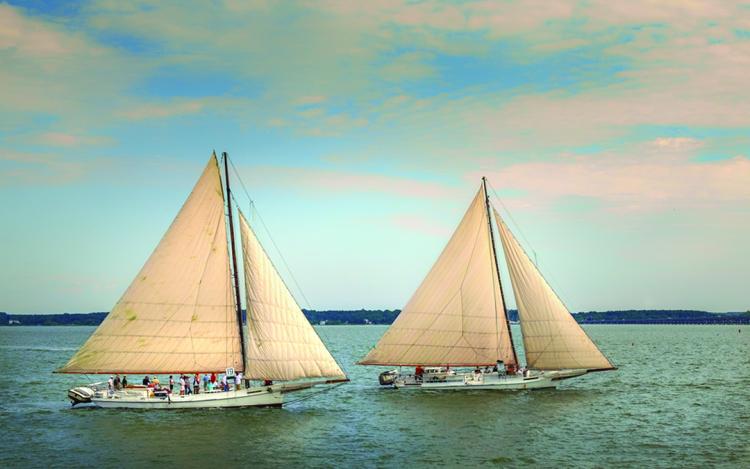
The largest of the Chesapeake’s Eastern Shore rivers, the Choptank winds for 68 miles from its non-tidal, freshwater beginnings in Delaware and Caroline County, MD, to its brackish mouth, over a mile wide, spanning from the tip of Tilghman Island in Talbot County to the southern crook of Cook Point in Dorchester County. One reason that is suggested why the intrepid Captain Smith did not venture into the Choptank is that its approach from the Bay in 1608 was guarded by the 600-plus-acre Sharps Island, which, historians note, most likely obscured the entrance to the river from Captain Smith’s view.
The island is yet another of the Chesapeake’s disappearing land masses. The remnants of the island, which once was a thriving agricultural community and later a tourist attraction featuring a three-story hotel and boardwalk, now sits below the waters of the Bay, marked by a shoal warning and a decommissioned lighthouse at the river’s west mouth.
The Sharps Island Light is the third lighthouse to stand nearly three miles south-southwest from the southern end of Tilghman Island. The first lighthouse was built on Sharps Island in 1838, but due to the island’s erosion, it was moved in 1848. This was replaced with a screwpile lighthouse in 1866 near the original location of the first structure. The second lighthouse lasted until 1881 when it was forced off its foundations by an ice floe. It floated nearly five miles down the Chesapeake—with its keepers still inside—until it ran aground, allowing the men to escape unharmed.
Novelist James Michener set his 1978 classic “Chesapeake” in and around the Choptank. In the 859-page novel, Michener describes the Indian Pentaquod’s first encounter with the Choptank: “Wherever he looked he saw a grand expanse of water forming itself into bays and creeks… and along the shores of these varied waters rose land of the most inviting nature… everywhere the impression of opulence, and quietness and gentle living… it was the most congenial place he had ever seen.”
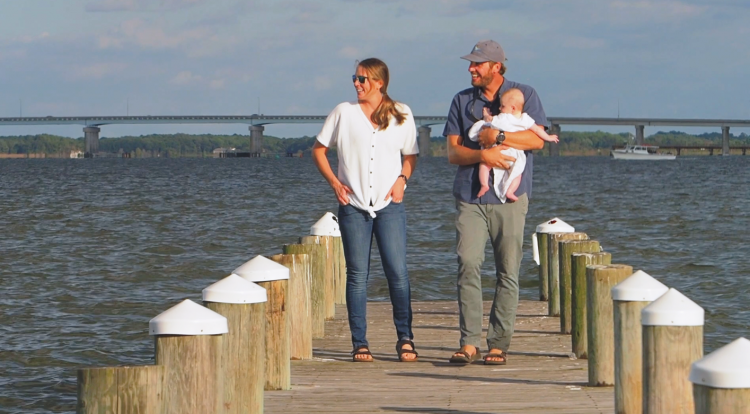
A haven for sailors, anglers, and watermen
While the ravages of time have changed some facets of the river, the Choptank remains to this day a haven for sailors, crabbers, fishermen, and watermen of all ages to enjoy.
Choptank Riverkeeper and director of the ShoreRivers Riverkeeper program Matt Pluta is one of the Choptank’s biggest advocates. Pluta points to the large expanse of water at the river’s mouth and its miles-long fetch that make it ideal for sailing.
“This river changes every couple of miles… our watershed is about 1000 square miles, most of it agricultural. This presents its own set of challenges with rising nitrogen and phosphorus runoffs… but all in all, I think this is the prettiest river on the Bay.”
Pluta says the robust white perch and rockfish fisheries as well as the river’s oyster reclamation programs are proof positive of the health of the river system. “But things could be better,” he says.
“The Choptank kicked my butt a couple of years ago. I had organized an inaugural open water swim, but we had to cancel it because of water pollution. We monitor over 30 sites twice a month for water quality. The health of the river is in flux. It changes based on rainfall and runoff. The lower part of the river is influenced by the water coming into it from the Bay; the upper part is more subject to agricultural runoff. It’s a big job to manage that runoff. Some of the larger farmers are very conscious about the impact their farming practices have on water quality. But it’s a big area with lots of stakeholders. At times I feel like we are just holding our own.”
Pluta points with pride to the Oyster Recovery Partnership and its Horn Point oyster hatchery. “This is one of the largest programs on the Eastern Shore. In fact, the Harris Creek project is the single largest oyster restoration undertaking in the world. We’ve estimated that the oysters in Harris Creek can filter all the water in the creek in 10 days and in the course of 10 years could remove over one million pounds of nitrogen from the water.”

Pluta says the past couple of years have been tough for the river’s replenishment efforts. “But we’re coming out of it. Last year was one of the greatest ever in terms of our replanted oysters reproducing on their own. Our shorelines and sanctuaries are starting to fill in. That’s what it’s all about.”
The Riverkeeper also points to increased populations of submerged aquatic vegetation (SAV) as another indication of the River’s health. “It’s been incredible,” he says. “Last year we had almost near perfect conditions.”
The 33-year-old Penn State graduate spends a good percentage of his time on the water either working at his job or enjoying the solitude of the river with his wife, toddler son Maxwell, and German shorthair pointer Rogue. “My colleagues and I work hard every day to create a better river for my son and future generations to enjoy. It’s up to us now to keep making incremental progress so when Max gets older, he will be able to enjoy more and better recreational opportunities on the Choptank.”
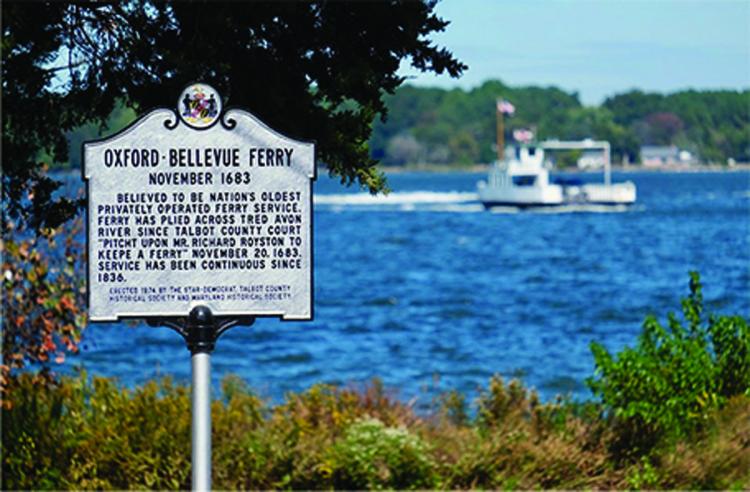
Favorite creeks and anchorages
Some of Pluta’s favorite creeks to explore and anchorages to enjoy include:
Broad Creek (lots of cool meanderings).
San Domingo Creek (gets you to the backside of St. Michaels).
The Tred Avon River (home to Oxford and the Scottish Highlands Creamery)
La Trappe Creek (a popular spot to anchor).
Cambridge Creek (check out Tl Morris Seafood in Trappe just before you get to the 50-foot Highway 50 bridge and JM Clayton and Snappers Waterfront Restaurant as you enter the creek).
Bolingbrook Creek (on the north side; go around the island for a great spot to drop the hook).
Another stop Pluta recommends is the Choptank Oyster Company. Located just past Castle Haven Point, the company is one of the oldest aquaculture operations in Maryland. Dockage is limited, but you can call ahead and arrange to pick up your fill of the company’s Choptank Sweets most times during the summer. Sweets are a robust, meaty oyster with a rich creamy texture, a sweet buttery flavor with a clean crisp finish. The moderate salinity of the Choptank River ensures the flavor is not overburdened with saltiness, thus allowing the more subtle and complex natural flavors of the oyster to be detected.
Oxford resident and catboat sailor Phil Livingston has spent almost 20 years exploring the Choptank and its tributaries. He offers this take on sailing on the Choptank:
“My favorite anchorages are the ones that I know no one else can get into. I usually find a place with single digit depth. Sailing a catboat with only 19 inches of draft allows me to go into some pretty shallow water. My record is spending the night in only two and a half feet of water! That was in Cook Point Cove.”
Another shallow-water anchorage Phil likes is Goldsboro Creek. “While this is deeper, it’s still shallow,” he says. “I usually go up until my centerboard starts to drag, which is at only four feet, four inches.”
Livingston is an unabashed Oxford booster. “Our little village is dripping with charm. When spending the night, I stay anywhere in Town Creek. If you want a slip with great facilities, Campbell’s is the place. I also like going out for a day sail and coming back to Town Creek where you can make a left just past Capsize (restaurant), stay close to the docks, and head over towards the cemetery. It’s about three to four feet deep and quiet. No spooky sounds from the graveyard!”
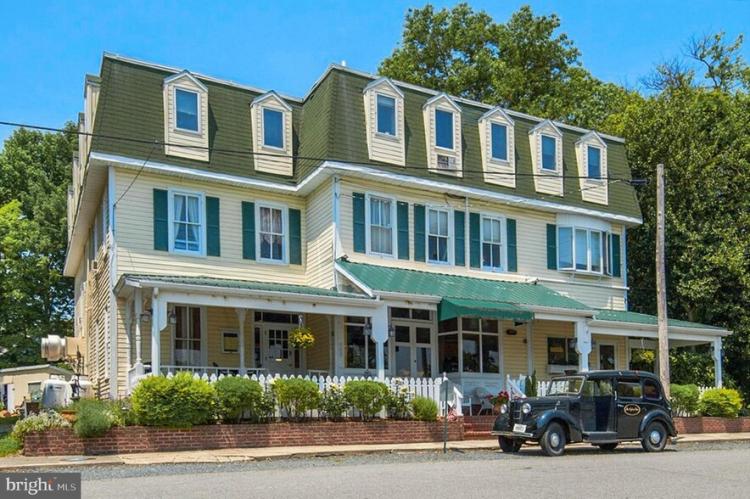
Where to eat in Oxford
There is no shortage of quality eateries in Oxford. Here is Livingston’s evaluation: “The first restaurant on my list is the Robert Morris Inn, which dates to the 1700s. General George Washington had lunch here. Then you have Capsize on Town Creek. They have dockage, so it’s a great place to go with your boat. The best part about it is you’re just across the street from the Scottish Highland Creamery, recently voted the best place in Maryland to get ice cream. Pope’s Tavern is at the end of Town Creek, and Latitude ‘38 is as you come into town. Finally, for the best sunsets on the River, it’s Doc’s on Pier Street. For simpler fare, Livingston recommends the Oxford Market on Main Street.
Livingston also recommends spending some time poking around Campbell’s Boatyard in Town Creek. “They are the premier boat builder and restoration outfit on the Eastern Shore. It’s worth your while to prowl their docks and check out their work.”
What’s so special about the Choptank? Livingston doesn’t mince words: “If you’re looking for lots of people, crowded waterways with lots of people, Annapolis, South River, or the Eastern Bay is the place you should be. If you want something simple and peaceful, you need to cruise the Choptank, drop anchor in skinny water, and take it slow.”
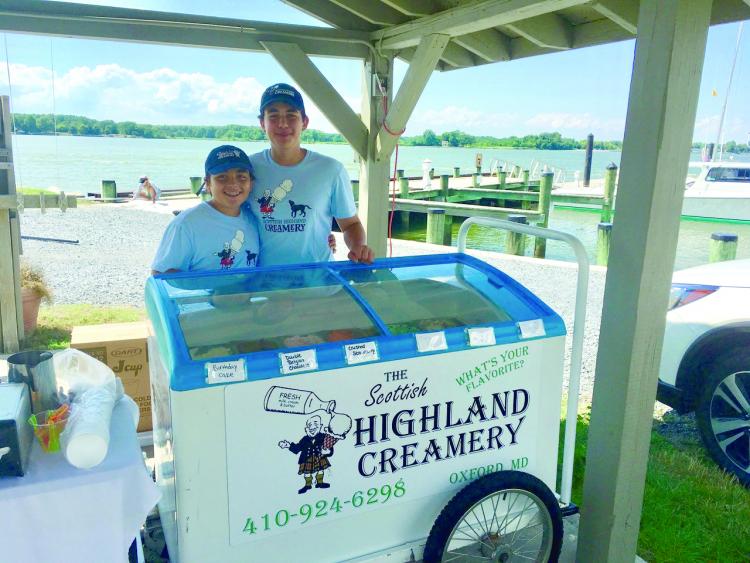
The scoop on ice cream
SpinSheet caught up with Highland Creamery owner Rich Leggett just as winter wound down. The creamery is an Eastern Shore mainstay, having been founded 16 years ago by Victor Barlow who earned his ice cream creds when he lived above an ice cream shop in his native Scotland. “My wife and I bought the Creamery three years ago,” Leggett says. “We work hard to keep Victor’s tradition of the creamiest, smoothest, most delicious ice cream alive here in Oxford. But no, I do not own a kilt!”
Rich describes the Creamery’s ice cream as “a super-rich concoction more like a gelato in style. We have hundreds of recipes. We make it all with locally sourced ingredients. Our secret? We make it by hand every day. There are no shortcuts to perfection.”
The most popular flavors are vanilla, chocolate, mint chip, strawberry, and coffee. “We make up some pretty exotic ice creams depending on our mood,” the former Wall Street businessman says. “There’s an Italian lemon cookie ice cream, red white and blue ice cream to celebrate our national holidays, Scottish whiskey shortbread, even an Old Bay flavored product.” Rich admits to making an oyster-flavored ice cream. “It wasn’t a big seller,” he says with a grin.
Rich and his team like to be part of the community. “We scoop at weddings and even funerals. In the winter we served ice cream for breakfast. If customers came in their PJs, we gave away free sprinkles. We are a gathering place during the summer. Sometimes the lines are long, but nobody is in a hurry. At the end of the day, we’re all about making people happy. The money is okay, but the smiles our customers give us makes it all worthwhile.”
Rich and his wife have recently renovated a store front on Main Street. “The Oxford Social Café is open year ‘round. We serve great coffee, pastries, and ice cream.”
My experience on the Choptank is limited to helping “plant” oysters on Harris Creek one hot, smelly July day a couple of years ago. Helping to load the one-ton cages with spat is a sloppy, slimy task made bearable because you know that your efforts will help the Choptank’s oyster population rebound and produce cleaner, healthier water in the future.
A few years later, I anchored just off Broad Creek and was amazed at the water clarity and a distinctive blue cast far different than what I had been used to in the West and South Rivers. When I mentioned this experience to Riverkeeper Pluta, he laughed. “I tell people the Choptank’s water looks blue twice a year. It all depends on how the sun hits it.” Blue or not, the Choptank River is an Eastern Shore gem well worth exploring.
Marinas in Cambridge
Cambridge Yacht Basin: They can accommodate boats from 20-200 feet in length.
Hyatt Regency: The golf resort, spa, and marina.
Book both at snagaslip.com
~ by Craig Ligibel




